Introduction
In the rapidly evolving landscape of text recognition, understanding the nuances between Intelligent Character Recognition (ICR) and Optical Character Recognition (OCR) is crucial for optimizing operational efficiency. ICR and OCR serve distinct yet complementary purposes, each excelling in different aspects of text digitization. OCR specializes in converting printed text from various sources into machine-readable data, making it indispensable for tasks such as automated data entry, document digitization, and text extraction from images.
It significantly enhances workflows across industries by reducing manual data entry errors and improving accessibility.
Conversely, ICR takes text recognition a step further by accurately interpreting handwritten text, accommodating diverse writing styles and nuances. This capability is especially valuable in sectors like healthcare, where managing handwritten patient records and prescriptions is a common challenge. By automating the digitization of such documents, ICR not only streamlines operations but also minimizes errors, thereby enhancing overall efficiency.
As the demand for precise and efficient text recognition technologies grows, both ICR and OCR continue to play pivotal roles in transforming how industries handle and process textual data.
Key Differences Between ICR and OCR
ICR (Intelligent Character Recognition) and OCR (Optical Character Recognition) are essential tools in character recognition, each fulfilling different roles. OCR excels in converting printed material from sources like books, receipts, and old letters into machine-readable data. This innovation is extensively utilized in automated data entry, document digitization, extraction of information from images, invoice processing, form recognition, and improving accessibility for visually impaired individuals. By converting both handwritten and typed material from various sources, including images and scanned documents, OCR remains a crucial component of modern technology, aiding in tasks such as reading product identifiers on assembly lines to update inventory tracking systems.
On the other hand, ICR progresses beyond OCR by interpreting handwritten characters, accommodating various writing styles and nuances. This capability makes ICR particularly valuable in sectors where handwritten notes are prevalent, such as healthcare. In this domain, managing patient records, medical histories, and prescriptions can be laborious and error-prone when done manually. ICR automates the digitization of these records, streamlining workflows and reducing errors. Both ICR and OCR are essential to the changing environment of character recognition, tackling distinct challenges and improving operational efficiency across various industries.
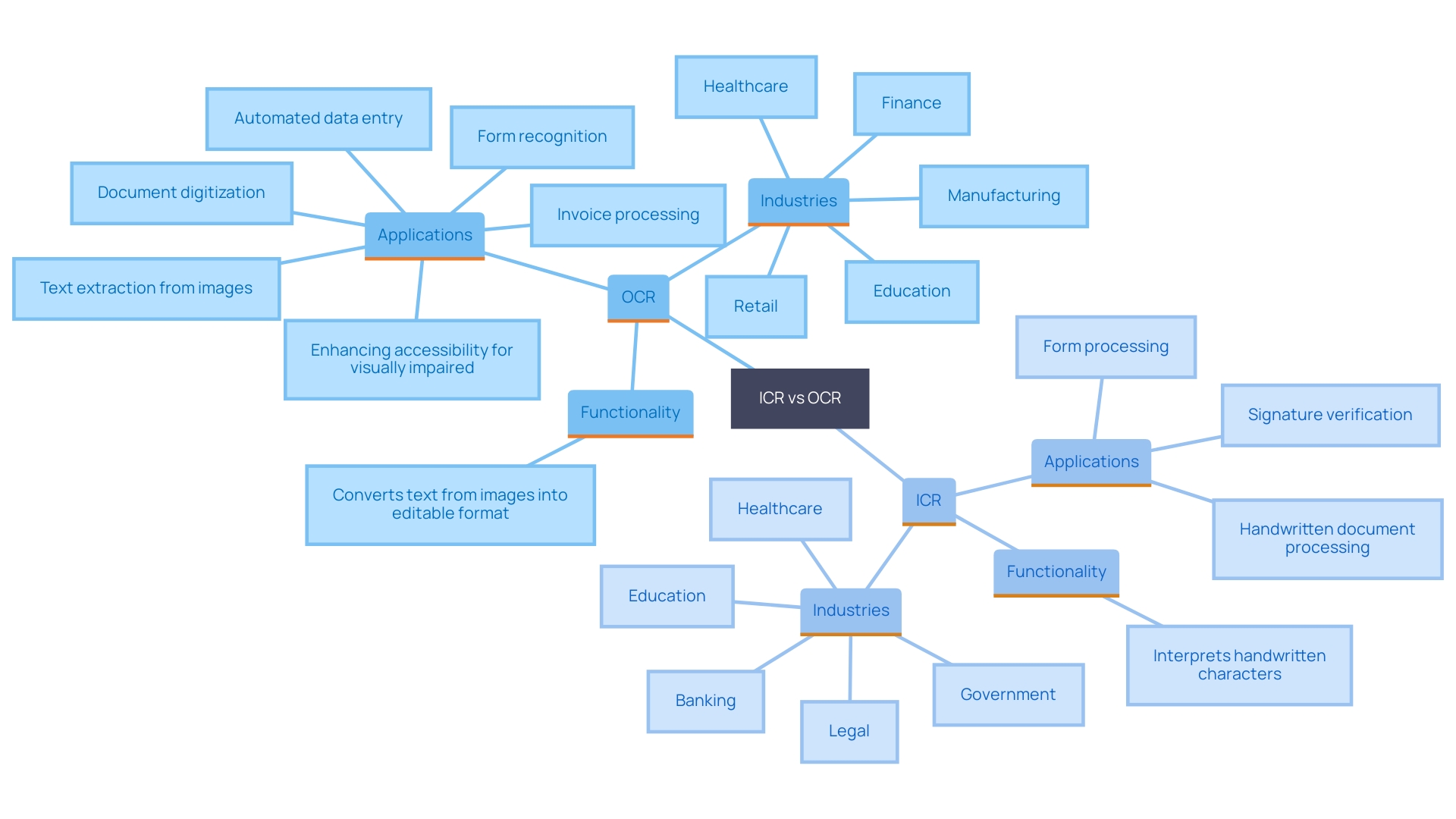
How ICR Works: Machine Learning and AI
Intelligent Character Recognition (ICR) leverages advanced machine learning algorithms and artificial intelligence to significantly enhance its accuracy and adaptability. By training on extensive and diverse datasets of handwritten characters, ICR systems develop the ability to recognize various symbols and writing styles. This training process allows ICR to continuously improve its performance, effectively addressing the variations in handwriting that often challenge traditional Optical Character Recognition (OCR) systems. The AI component of ICR goes beyond simple character recognition; it can analyze context and semantics, further boosting its recognition capabilities.
A recent example of such advancements comes from a team of researchers at MBZUAI, who have developed an AI program capable of learning an individual’s handwriting style and producing writing that mimics their hand. ‘This innovation, which has received a patent from the United States Patent and Trademark Office, has the potential to assist individuals who are unable to write due to injuries.’. It can also generate large amounts of data to improve machine learning models for processing handwritten scripts. Hisham Cholakkal, an assistant professor of computer vision at MBZUAI, highlighted the project’s origins in curiosity about whether a model could learn and replicate someone’s handwriting style from just a few samples.
Moreover, the project underscores the importance of a global receptive field in understanding handwriting. As Fahad Khan explained, analyzing the entire content allows the model to grasp how characters are ligated, letters are connected, and words are spaced. This holistic approach, which utilizes a transformer-based method, has proven effective in English and is being explored for other languages like Arabic, known for its complex letter connections in handwritten form.
These advancements underscore the transformative capabilities of ICR innovations, rendering them essential for contemporary uses that necessitate precise and adaptive handwritten character recognition.
How OCR Works: Pattern Recognition and Image Processing
Optical Character Recognition (OCR) technology utilizes advanced pattern recognition and image processing methods to transform printed or handwritten characters into a digitally editable format. Initially, the system acquires images through scanning or capturing digital photos. Preprocessing steps, such as noise reduction and binarization, enhance the visibility of the written content. The core function of OCR involves segmenting written content into individual characters and recognizing each based on its shape, comparing it to a predefined library. While this method excels with standardized fonts, it often faces challenges with irregular or poorly printed text.
OCR is indispensable in various sectors. For instance, in healthcare, cloud-based OCR automates digitizing handwritten patient records, significantly reducing manual entry errors and saving time. This innovation also finds extensive applications in automated data entry, document digitization, and invoice processing. As we navigate the age of digital transformation, OCR continues to be a crucial component for efficient data extraction and analysis, revolutionizing how we handle vast amounts of textual data.
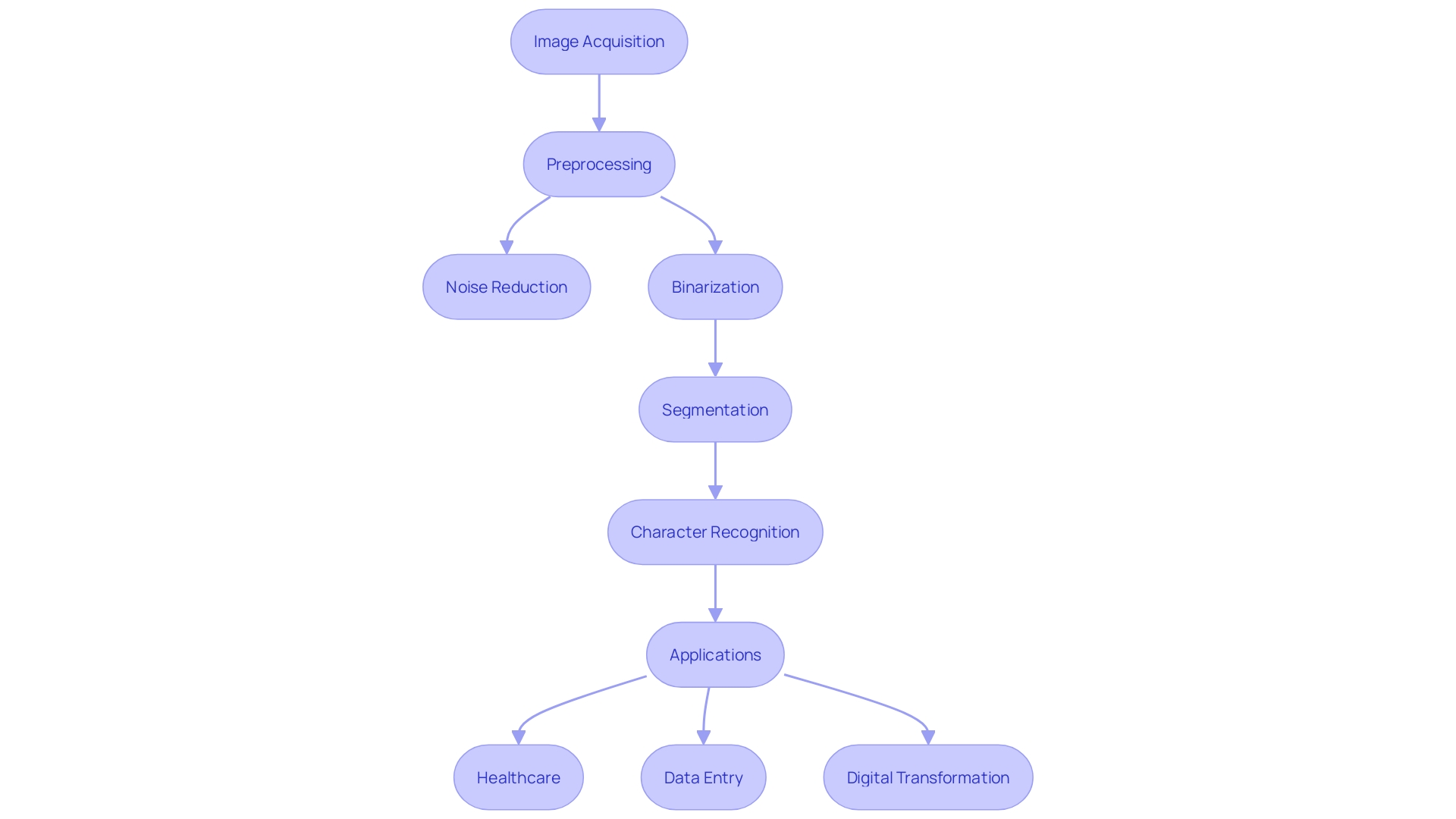
ICR Applications: Handwritten Text Recognition in Various Industries
ICR systems are transforming various sectors by converting handwritten information into digital form. In healthcare, it automates the digitization of patient records and prescriptions, significantly improving data accessibility, accuracy, and reducing administrative burdens. For instance, cloud-based OCR solutions can automate the transfer of handwritten notes into electronic health systems, cutting down on manual entry errors and saving time. This transformation is crucial, as healthcare providers often spend over 50% of their time on administrative tasks like writing visit notes, which can lead to burnout.
In the finance sector, ICR streamlines the processing of checks and forms, enhancing operational efficiency. Educational institutions also leverage ICR to automate the grading of handwritten exams, thereby reducing the administrative load and ensuring quicker, more accurate results. These applications highlight the versatility of ICR systems in addressing document processing challenges across various industries.
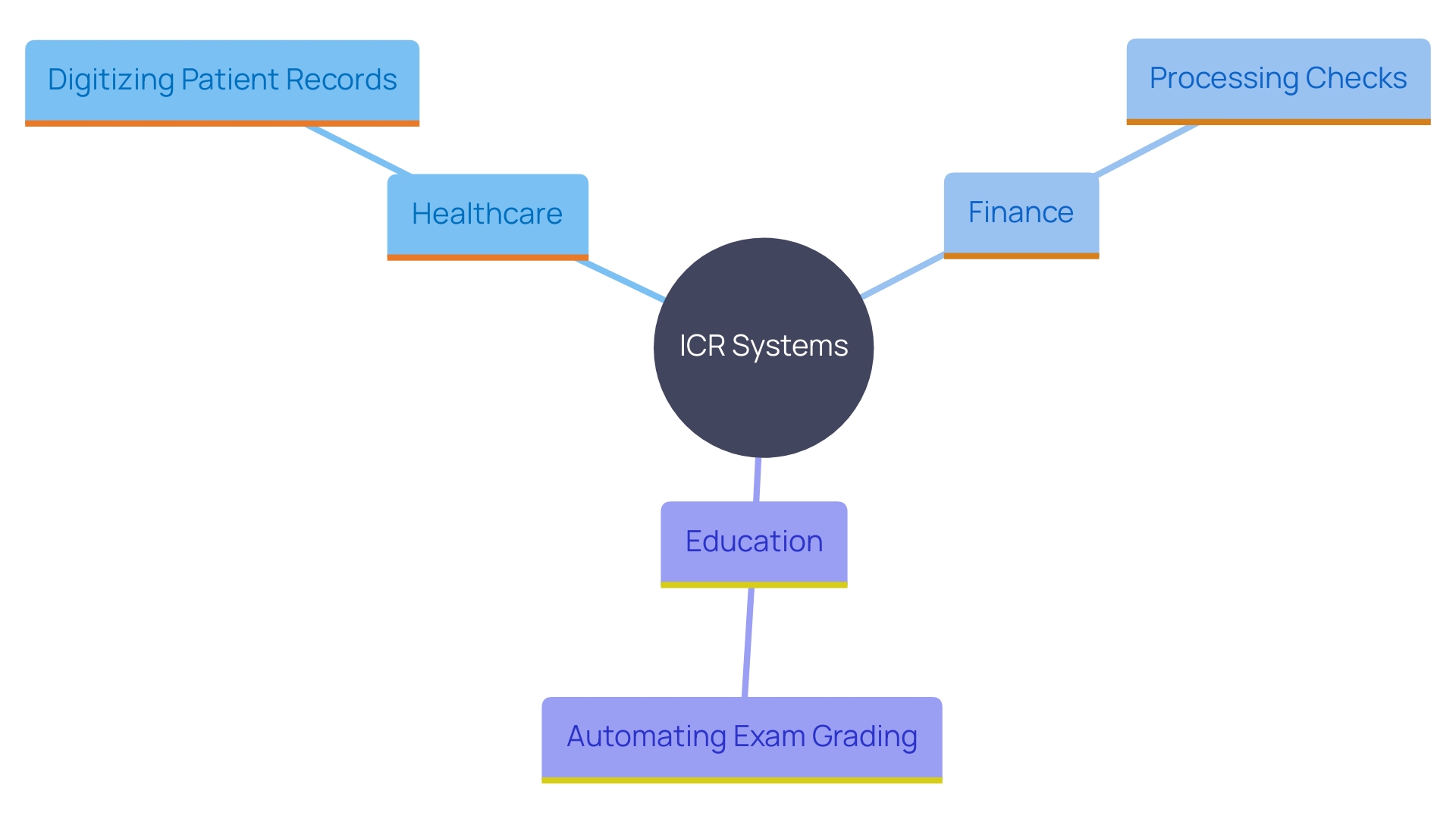
OCR Applications: Printed Text Recognition in Document Management
OCR methods have become a cornerstone in document management systems for digitizing printed materials, fundamentally altering how organizations handle data. By converting paper-based documents into searchable digital formats, OCR enhances both storage efficiency and retrieval speed, addressing the pressing need for quick access to vital information. ‘This innovation is particularly impactful in industries like legal and insurance, where it automates the processing of contracts, claims, and other text-heavy documents.’. This automation significantly reduces manual entry errors and improves turnaround times, leading to substantial efficiency gains and cost savings.
The healthcare sector also benefits immensely from OCR. Managing patient records, a traditionally laborious task prone to errors, has been revolutionized by cloud-based OCR. ‘This innovation automates the digitization of handwritten notes, medical histories, and prescriptions, streamlining workflows and enhancing the accuracy of patient data management.’.
Moreover, OCR contributes to environmental sustainability by reducing the dependency on paper. The recycled paper industry, for instance, highlights the potential for technological advancements to drive cost savings and sustainability. In the U.S., this industry generates approximately $90M in annual revenue and employs over 100,000 people, emphasizing the significant economic and environmental benefits of reducing paper consumption through OCR technology.

Comparing ICR and OCR: Accuracy, Cost, and Implementation
When comparing ICR and OCR, accuracy is a crucial element affected by the kind of content being processed. ICR excels in recognizing handwritten characters, making it invaluable for tasks like digitizing patient records in the healthcare sector. This process traditionally required manual entry, which was both time-consuming and error-prone. However, ICR’s advanced algorithms and the need for extensive training data often result in higher costs. On the other hand, OCR provides a more economical option for printed material recognition and is generally simpler to implement because of the wide range of available software solutions. Automating the digitization of documents such as invoices, contracts, and customer forms with OCR can lead to substantial efficiency gains and cost savings. Organizations must evaluate their particular requirements and the characteristics of the text they manage to identify the most appropriate solution. As one expert observed, ‘Manual data entry and document processing have long been costly drags on productivity and efficiency for organizations of all sizes.’ By utilizing the appropriate tools, businesses can significantly enhance their operational efficiency.
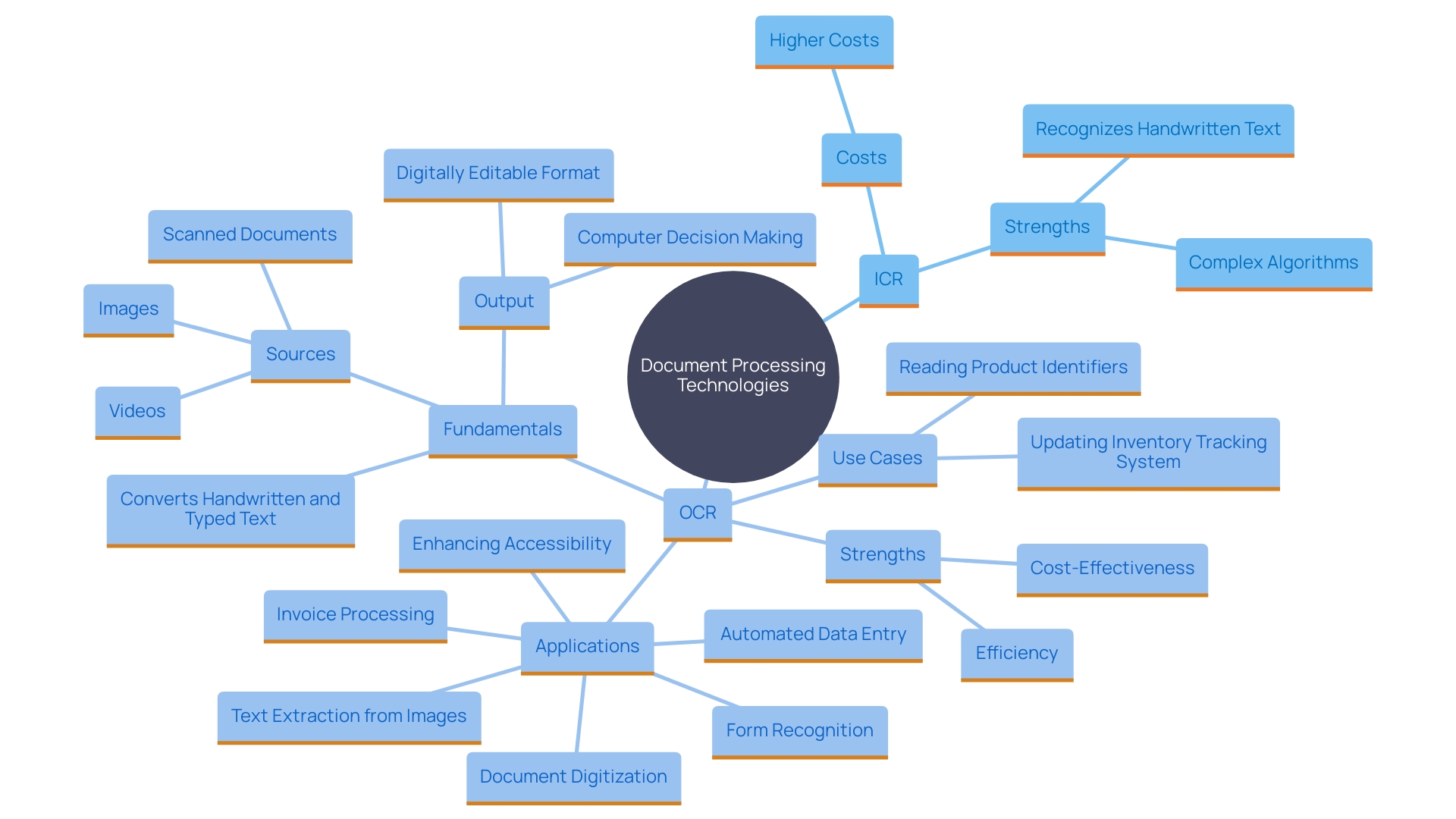
Choosing the Right Technology: ICR vs. OCR for Specific Needs
Selecting between ICR and OCR systems requires a comprehensive grasp of your organization’s document processing requirements. If your business primarily handles printed materials such as invoices, contracts, and reports, OCR can be a cost-effective solution. OCR excels at converting printed material into machine-readable data, significantly reducing the time IT employees spend searching for and collating information, which can cost up to $120 per employee per day.
However, for organizations managing a high volume of handwritten content, such as medical notes or legal documents, ICR systems are essential. ICR offers superior adaptability to varied handwriting styles and layouts, ensuring that even the most complex documents are accurately digitized. In the healthcare sector, for instance, the transition to cloud-based OCR and ICR has revolutionized the digitization of patient records, automating a process that was previously time-consuming and prone to errors.
Understanding the diverse formats and layouts of your documents is critical. Enterprise content can include plain text, formatted text, tables, charts, and handwritten notes, each presenting unique challenges for data extraction. By leveraging AI and machine learning, modern document processing solutions can handle this complexity, ensuring that your data is accurately captured and efficiently processed.
Integrating advanced document AI solutions can drastically minimize the manual effort needed for data entry and document processing, providing substantial efficiency improvements and cost reductions. As unstructured data is projected to make up over 80% of enterprise data by 2023, selecting the right technology—ICR for handwritten content and OCR for printed materials—will be pivotal in streamlining your operations and enhancing productivity.

Best Practices for Implementing ICR and OCR
To ensure the successful application of ICR and OCR methods, organizations should adopt several best practices. Begin with a comprehensive analysis of document workflows to pinpoint areas where automation can deliver the most significant benefits. For instance, in the healthcare sector, managing handwritten patient records has traditionally been a labor-intensive process. However, cloud-based OCR has revolutionized this by automating the digitization of medical histories and prescriptions, drastically reducing errors and saving time.
High-quality input images are essential for both ICR and OCR systems. Poor image quality can severely impact accuracy, so it’s essential to maintain clear and precise document scans. Regularly updating and training ICR systems with new handwriting samples is another crucial step. This continuous learning process ensures the system remains effective over time.
Gradual integration of these technologies is advisable. This approach allows teams to adapt incrementally, reducing resistance to change and facilitating smoother transitions. Continuous measurement of effectiveness is also vital. By monitoring performance metrics regularly, organizations can make necessary adjustments to optimize efficiency and productivity.
A case in point is ICL, a multi-national manufacturing and mining corporation. ICL faced challenges with manual monitoring of equipment in harsh conditions. Implementing automated document processing helped streamline their monitoring processes, reducing costs and improving accuracy. Similarly, intelligent document processing (IDP) has brought transformative changes to industries like insurance, by automating the processing of unstructured and semi-structured documents, leading to incredible efficiencies and reduced human errors.
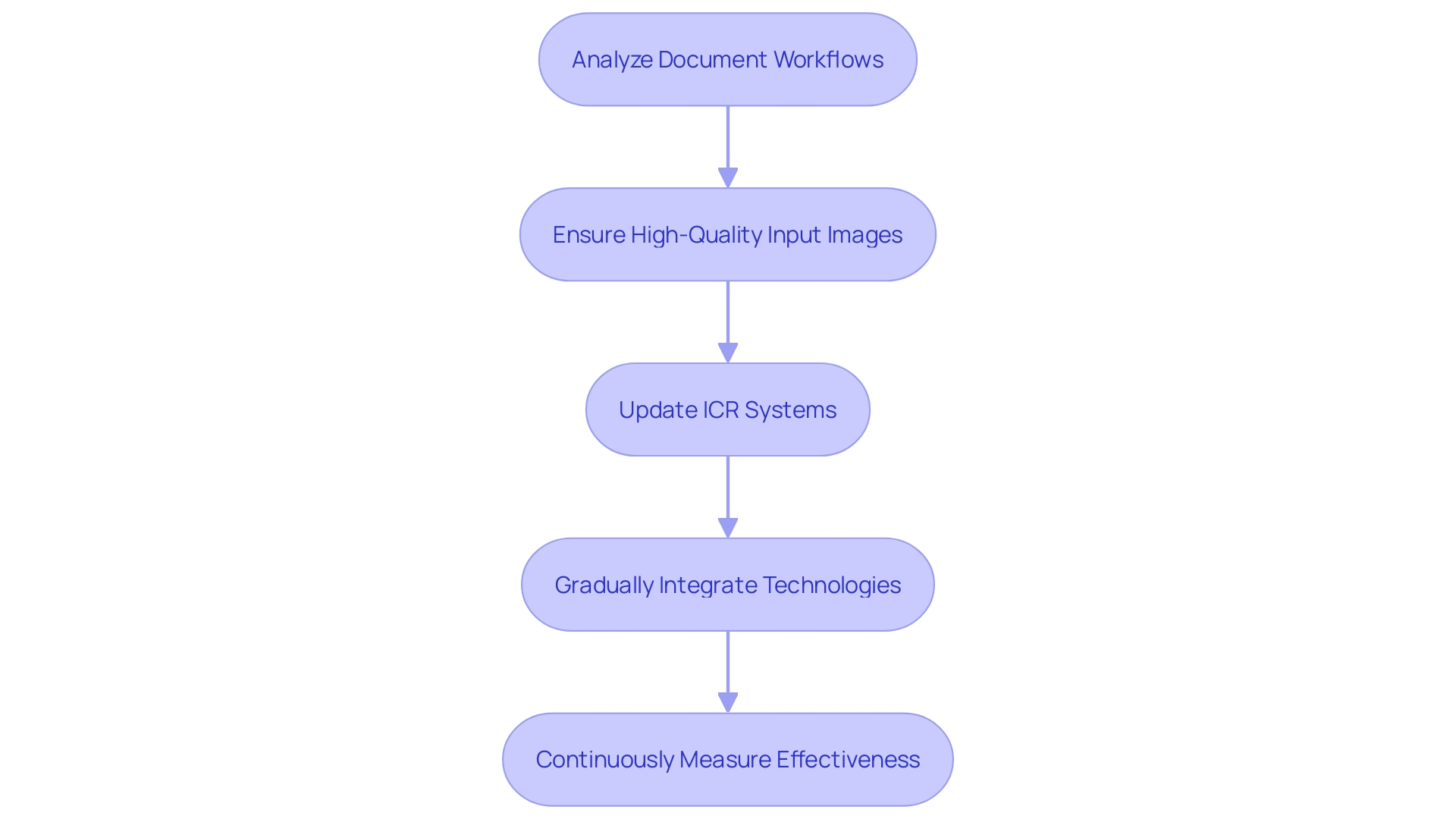
Conclusion
The exploration of Intelligent Character Recognition (ICR) and Optical Character Recognition (OCR) highlights the unique strengths and applications of each technology in enhancing operational efficiency across various industries. OCR remains a vital tool for converting printed text into machine-readable formats, streamlining tasks such as document digitization, automated data entry, and improving accessibility. Its broad applicability makes it indispensable in sectors like healthcare, legal, and finance, where accurate data management is crucial.
In contrast, ICR takes text recognition to a new level by effectively interpreting handwritten text. This capability is particularly valuable in environments where handwritten notes are common, such as in healthcare and education. ICR not only automates the digitization of handwritten documents but also adapts to diverse writing styles, significantly reducing manual errors and administrative burdens.
When choosing between ICR and OCR, organizations must consider their specific needs. For those primarily dealing with printed material, OCR offers a cost-effective and efficient solution. However, for businesses managing a high volume of handwritten documents, ICR is essential for ensuring accuracy and adaptability.
Implementing these technologies requires careful planning, high-quality input, and a commitment to continuous improvement to maximize their benefits.
By leveraging the appropriate text recognition technology, organizations can streamline their operations, enhance productivity, and ultimately drive significant cost savings. Understanding the distinct advantages of ICR and OCR empowers businesses to make informed decisions that align with their operational goals, paving the way for a more efficient future.

